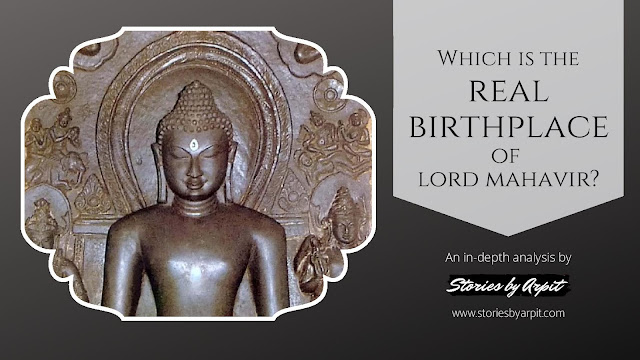The year was 1955. A
Charipalit Sangh (pilgrimage carried out on foot) initiated by Sanghpati Shri
Fatehchand Motichand Vakharia was on its way back to the town of Himmatnagar (in Gujarat) after
completing a 28-day arduous journey to the shrine of Lord Kesariyaji (Adinath)
situated in the Dhulev town of Mewar (now Rajasthan). Param Pujya Acharyadev Shrimad Vijay Dharmasurishwarji
Maharaja led the Sangh consisting of nearly 50 Sadhu-Sadhvijis (monks &
nuns) and 200 pilgrims along with a substantial support staff among others.
 |
| The grand Jain temple of Abhapuri - Polo Forest |
Just a few days away from its
final destination, the Sangh camped on the outskirts of a forest couple of kilometers from the town
of Idar, on a sunny day in March. Huge tents were erected at the spot and a
grand feast was prepared not only for the pilgrims but also for the local villagers
and Bhils (tribals) living in the nearby forests.
 |
| The Nritya Mandap at Lakha Mandir - Polo Forest |
A grand Snatra Puja (ritual
recreating the birth celebration of lord) was being conducted at the makeshift
temple, when hundreds of Bhils arrived at the venue. Unknown with the rituals, they curiously watched the entire
proceedings with their entire focus transfixed on the idol of the lord. As soon as the
Snatra puja ended, the Bhils rushed to inform the revered Acharya something that they had seen and had left them bewildered.
 |
| Temples at Polo Forest |
In his broken Hindi, the leader
of the tribe bowed before the revered Acharya and conveyed that, deep within their jungles, there
were many ruined Jain temples and idols similar to the
idol on which the Snatra Puja was conducted. Enthused with this information, Acharyashri
decided to visit the forest and asked the Bhils to show him the temples.
However, the Sanghpati along with other volunteers requested Acharyashri not to
venture into the dangerous forests as they feared
that it would be infested with wild animals as well as venomous snakes. Further, the volunteers also tried to reason with Acharyashri that the Bhils should not be trusted
as they may have planned to rob everyone on the pretext of showing the idols.
 |
| The beautiful Rang Mandap of Lakha Mandir |
Ignoring all the warnings, Acharyashri ordered the Sanghpati to make the
necessary arrangements as he was sure that the Bhils did not have any malafide
intentions. Along with Sanghpati Shri
Fatehchand and a handful of support staff, Acharyashri ventured
deep into the forest following the Bhils without any fear. After hours of
walking, Acharyashri’s feet were tired but his heart was eager to witness the
idols. At around 5 PM in the evening, the entire batch led by the Bhils reached
a clearing, on the banks of Harnav river when the Bhils announced that the
temples were nearby. In the horizon of the glimmering orange sky, Acharyashri
saw clusters of temples at a distance! As his heart leaped with joy, the entourage moved towards the largest temple.
 |
| Lakha Mandir at Polo Forest |
Known as the “Lakha Mandir” by
the Bhils, the beautiful temple was situated in the midst of Aravalli range amidst overgrown dense
shrubs. While the main Shikhar (spire) of the temple was intact, the dome of
the Nritya-Mandap (outer chamber) was completely destroyed. Acharyashri’s heart
was shattered as he saw that mostly all the idols had been destroyed and those
which were less damaged had been plastered with cow dung cakes by tribal women! In the fading light, Acharyashri studied each
of the idols and identified five less damaged ones, including the
towering 51-inch idol of Lord Adinath which was the Mulnayak (main deity) of the Lakha
Mandir. After visiting all the nearby temples as well, Acharyashri requested
the Sanghpati to carry the five identified idols back with them as he feared
that if left in the forest, these idols would either fall into wrong hands of robbers
or the Archaeological survey would take them into their custody.
 |
The recovered idols at Himmatnagar Jain temple
|
 |
| Ruins of Jain Idols (note the intricate patterns on the hands and legs) |
The next morning Sanghpati Shri
Fatehchandji and his team of went back to the Lakha Mandir and rewarded each of
the Bhils handsomely. The Bhils and the support staff took hours to carefully
dismantle the less damaged idols and placed them in a vehicle. In the dead of
the night at around 2 AM, the entourage along with 5 divine idols, left the
ruins and reached the town of Himmatnagar
before dawn. The idols were placed in a house in the outskirts of the town
where the cleaning process was initiated and the damaged parts were restored
with a solution made of freshwater pearls and marble powder.
 |
| Restored Nashika's (nose) of the idols |
After 6 days, when the entire
Charipalit Sangh reached Himmatnagar, the idols were carried to the main temple
amidst great fanfare. A ritual of 18 Abhishek was conducted under the presence
of Acharyashri to restart the puja of the lord. Later, Acharyashri studied each
of the idols in detail and pondered over each of the inscriptions that were
carved on them which revealed that 3 of the idols (51” Mulnayak idol of Lord
Adinath; 37” idols of Lord Sumtinath and Lord Shantinath ) were installed by
Acharya Shri Hemvimal Suri of the Tapagaccha sect of Jainism in the year of
1495 AD. The other two idols (45” idol of Lord Adinath and 41” idol of Lord
Shantinath) were installed by Acharya Shri Somsundar Suri in 1440 AD. On
detailed study of the temples and the region, it was discovered that the
temples were once a part of the lost city of Abhapuri city settled by Chand
Raja who was cured of his curse at Suraj Kund on the Shatrunjay hill. Presently, under the guidance of Acharyashri Rajratna Surishwarji Maharaja (disciple of Acharyashri Dharmasurishwarji Maharaja) the Himmatnagar Sangh is planning to reinstall the recovered idols in a new temple on the Himmatnagar Highaway.
 |
| Acharya Shri Dharma Surishwarji Maharaja (left) and Sanghpati Shri Fatehchand Vakharia (right) |
 |
Way to an inner tunnel which connects the Lakha Mandir with the the town of Idar which is 80 kms away!!!
|
 |
| Sunlight peeping in through intricately carved windows (note the ruins of the idols below) |
 |
Ruins of Jain Temples at Polo Forest
 |
| Jain Temples at Polo Forest |
|
|
|
Beautiful Archway at Polo Forest
|
This ancient city of Abhapuri was built around the river Harnav, an ancient water body spoken of in the Puranas. Now known as the "Polo Forest", it is believed to have been established in the 10th century by the Parihar kings of Idar, and was then conquered in the 15th century by the Rathod Rajputs of Marwar. The name is derived from pol, the Marwari word for "gate," signifying its status as a gateway between Gujarat and Rajasthan. Built between Kalaliyo in the east, the highest peak in the area, and Mamrehchi in the west, the land is considered sacred by the local Bhils. Together they block sunlight for most of the day, which might provide an explanation for the otherwise mysterious abandonment of the ancient city. Apart
from the Jain temples, which are renowned for their exquisite architecture,
there are shrines dedicated to Shiva as well. There is a Vireshwar temple,
where the roots of a Banyan tree provide water since ages.
 |
| Ruins of Jain temples at Polo Forest |
 |
| Beautiful Carvings at Lakha Mandir |
Further, the forest is home to
450 species of plants, 275 species of birds, 30 species of mammals and 32
species of reptiles. In its dense canopies lurk bears, leopards, hyenas, flying
squirrels and other elusive animals. The tribals who still reside in the forest
are descendants of those Bhils who had helped Maharana Pratap during his
refuge. In recent times, Gujarati movies like Reva have been also shot at these temples.
 |
| The beautiful ruins |
 |
| Overgrown shrubs dominate the Shikhar of the Lakha Mandir |
|
|
Intricate carvings on the dome of Lakha Mandir
|
However, a question arises: How
did a fully functional city with splendid temples, gardens and architecture be
ruined and lost in the passage of time? Blockage of sunshine? Foreign invasions? Only time can tell the true story. Till then we can
just marvel at the beautiful ruins embellished with intricate carvings that lie
gathering dust in the mystery of abandonment and decay.
 |
| The beautifully carved doorway |
 |
| Idols of the commissioners of the temples |
How to reach:
Polo forest can be reached within
3 hours from Ahmedabad. One can drive down NH8 from Ahmedabad to Idar (110km)
and then take NH 76A for the last 38 km to Polo Forest. The forest is 60km from
Himmatnagar and 25km from the town of Idar.
Liked this blogpost? Now Download this entire blogpost as a magazine in an easy to read and share PDF format by clicking here.
 |
| Polo Forest - Where every ruin has a story to tell |
I am thankful to Shri Mihir Vakharia (great grandson of Shri Fatehchand Vakharia) for providing valuable insights for this post.

































Thank you, Mr. Arpit for a Virtual tour of Abhapuri temples. Very Detailed Explanation.
ReplyDeleteVery nice Arpit
ReplyDeleteReally it's pleasure to get the detailed information about the Lost Jain temple as Polo forest (Abhyapuri)
ReplyDeleteVery intriguing information on the ancient ruins of Jain Temple. I’m proud to be a Jain. Keep it up bro.
ReplyDeleteRevealing! Rich heritage of Jain history. Thanks for this illustrated essay.
ReplyDeleteGlad you found it informative ! :)
DeleteFabulous information. Great work
ReplyDeleteVery informative. Thank you Arpit Shah
ReplyDeleteThank you!
DeleteWhat a wonderful story! I could feel that I was there, along with the Sangh, making that discovery! Such a gorgeous place... Pod(soft d/rolling l) is also commonly used in Sidhpur Patan.
ReplyDeleteTook me on a time travel to the past.
ReplyDeleteCan you share your contact no.?
ReplyDeleteHi Arpit. Thanks for the detailed well written insight. Would like to know some more details from you if possible. How can I get in touch with you?
ReplyDeleteMy name Gunjan Shah available at gunjan16@hotmail.com
DeleteVery informative article on jain heritage, thanks arpit
ReplyDeleteThanks for share great and memorable information about our Jain temples and plolo
ReplyDeleteHey i would like to know what is the name of temple. where this jain idols have been put in himmatnagar?
ReplyDelete